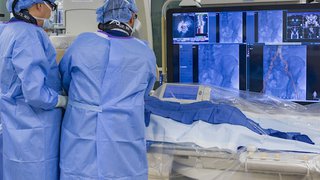Expert Care for All Types of Aneurysms
An aneurysm is a bulging, weakened area of a blood vessel or an area where a blood vessel is dilated and larger than normal.
An aneurysm can be located in many areas of the body, such as the blood vessels of the brain, the aorta (the largest artery in the body), the intestines, the kidney, the spleen, and the vessels in the legs. The most common location of an aneurysm is the aorta, which carries oxygenated blood from the heart to the body.
UT Southwestern’s multidisciplinary approach to treating aneurysms – involving interventional radiologists, vascular surgeons, and neurosurgeons, depending on the type of aneurysm – allows us to provide expert care for all types of aneurysms.
Neurosurgeons in the Peter O’Donnell Jr. Brain Institute perform more pre-emptive surgeries to prevent aneurysm-induced stroke than any medical center in the region, having performed more than 2,500 of these surgeries over the past decade.
Our interventional radiologists specialize in treating aneurysms and the areas of the body they affect. These specialists have advanced fellowship training in interventional radiology, plus extensive real-world experience.
About Aneurysms
Aneurysms can accumulate into a blood clot, and this clot can break off and become lodged in smaller blood vessels downstream, causing damage to the organ. Larger aneurysms can rupture, which can be life-threatening.
Aneurysms occur mostly in arteries that carry fast-flowing blood, and they result from the weakening of the blood vessel’s wall. This weakening can happen for many different reasons, such as genetic diseases, trauma, atherosclerosis, and infection.
Types and Symptoms of Aneurysms
Symptoms associated with aneurysms depend on the location of the aneurysm in the body. The symptoms often resemble other medical conditions or problems.
Symptoms that can occur with different types of aneurysms include:
- Abdominal aortic aneurysm (AAA): Constant pain in abdomen, chest, lower back, or groin area
- Brain (cerebral) aneurysm: Sudden severe headache, nausea, vomiting, visual disturbance, or loss of consciousness
- Common iliac aneurysm: Lower abdominal, back, or groin pain
- Femoral and popliteal artery aneurysm: Easily felt pulsation of the artery located in the groin area (femoral artery) or on the back of the knee (popliteal artery)









